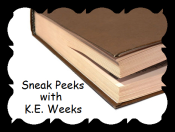 |
| This feature is presented by guest blogger, K.E.Weeks. |

Escape from Camp 14: One Man's Remarkable Odyssey from North Korea to Freedom in the West
Shin’s story is told factually, without much sentiment or additional information about North Korea, except what is necessary for context. Likely, this is because the author, Harden, is a newspaper correspondent and accustomed to being concise. The book is a quick, linear read. Shin’s abnormal upbringing creates an emotional distance between him and the reader that makes it difficult for the reader to relate to the protagonist.
The book is appropriate only for upper-level high school students, seniors perhaps, as life within the camp was brutal and violent. For instance, on one occasion, Shin watched a teacher beat an elementary-school student to death with a lecture pointer. Escape from Camp 14 contains photographs of Shin and the leaders of the North Korean Kim Dynasty, as well as drawings of life within the camp. The drawings are very disturbing, including one of Shin, at thirteen, being roasted over live coals. Still, it gives readers a unique perspective on life within prison camps in general and North Korea in particular. I give the book four stars (out of five). While I find it difficult to say that I liked the book, it is well-written, informative, and fills a gap in knowledge about a clandestine part of the world.

I much preferred Nothing to Envy: Ordinary Lives in North Korea
The country is so completely backward that its infrastructure is crumbling and electricity is only available in only the largest cities, and even then for only a few hours a day. The darkness is a good metaphor for the lack of information North Korean citizens have about the outside world. Nothing to Envy describes in detail what life is like for average citizens who live under the oppressive communist regime where even everyday necessities like food and soap are restricted, regulated, and distributed by the government. The book also describes the epiphanies, the moments, the defectors realize the government has lied and betrayed them. In addition, the book chronicles communism in southeast Asia, as China becomes a capitalist powerhouse and the USSR collapses in the early 1990s, and how it impacts North Korea and Kim Jong-Il’s reign.
Demick has chosen to focus on Chongjin, a crumbling, undesirable city in the northeast corner of the country because she felt that she could give readers a more realistic picture of life within North Korea if all of the defectors came from the same area. She could also cross-check facts this way. The book begins with two star-crossed lovers, much like Romeo and Juliet, who must meet in darkness because they are from different “castes” of society, Mi-Ran and Jung-Sang. It also follows:
Mrs. Song - a housewife who is a fervent regime supporter
Oak-Hee - Mrs Song’s rebellious daughter
Kim Hyuck – an orphan boy
Dr. Kim - a female doctor
and, as previously mentioned,
Mi-ran – a schoolteacher
Jun-sang - a promising college student and intellectual
My only complaint about this book is, at the beginning, it is difficult to follow because it bounces around between the defectors’ stories. It would have benefitted from a “cast of characters” list at the front. It takes a while before the reader is able to discern one character from another. However, this complaint is minor, and once the reader has the characters firmly affixed in her mind, the stories are haunting. For instance, when Dr. Kim escapes to China, starving and wet from the river crossing, she spies a bowl of rice on the ground. She has not seen rice for years, and cannot imagine why anyone would leave it on the ground. Then, she hears a dog bark. At that moment, she realizes that dogs in China eat better than doctors in North Korea.
While writing this review, I stumbled upon another’s review and thought it well written: http://llanoralleyne.com/2010/07/nothing-to-envy/ . If you’d like more information about the book, I recommend reading this review. Although Nothing to Envy does not dwell on violence and there is only a mild romance, it is still only appropriate for high schoolers because of the harsh realities of the book, which takes place mainly during the famine of the 1990s where millions starve to death, including several characters’ family members. I highly recommend the book for high school students studying communism, world geography, economics, or North Korea, or for those who just need a dose of gratitude for their lives. I give the book five stars (out of five) for its poignant descriptions and ability to foster a strong emotional connection between the reader and the defectors.
The title Nothing to Envy comes from a North Korean children’s song:
Our father, we have nothing to envy in the world,It is heartbreakingly sad that North Korean schoolchildren are required to memorize and recite this song, while they are dying from malnutrition.
Our house is within the embrace of the Workers’ Party.
We are all brothers and sisters.
Even if a sea of fire comes toward us, sweet children do not need to be afraid,
Our father is here.
We have nothing to envy in this world.
Disclaimer: The purpose of this review is to guide parents into selecting appropriate, significant, high-quality literature for their teens and tweens. I have no connection with the author or publisher of this book. I am a home educator of two children, 12 and 14, with a Master of Art degree in American Literature and a keen interest in young adult fiction and nonfiction.

No comments:
Post a Comment